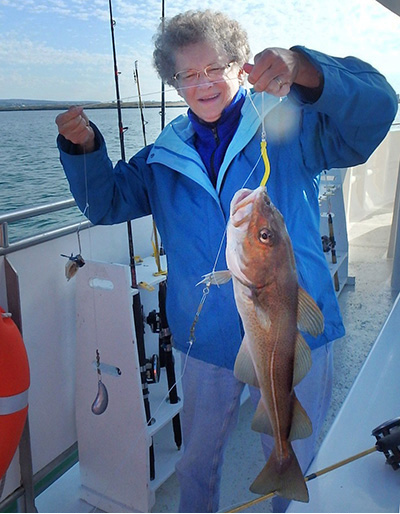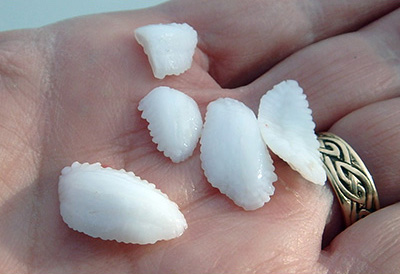Recent Headlines

Dr. Karin Limburg with a cod caught in Iceland, one of the few places in the world with a sustainable cod fishery
ESF Researcher Joins International Project on Baltic Sea Cod
Dr. Karin Limburg, a fisheries ecologist at ESF, is leading part of a major international research project focused on determining the age of Baltic Sea cod, a piece of information that is vital in establishing sustainable fishing quotas.
 Cod is an iconic species for the Baltic Sea, both as a top predator in the ecosystem
and as a source of income for fisheries. Reliable estimates of the variation in population
size and demography are necessary to manage cod stocks, and analysis of the cod's
age is a vital piece of information. However, oxygen depletion in the water recently
has made it increasingly difficult for researchers to estimate the age of cod in the
eastern Baltic.
Cod is an iconic species for the Baltic Sea, both as a top predator in the ecosystem
and as a source of income for fisheries. Reliable estimates of the variation in population
size and demography are necessary to manage cod stocks, and analysis of the cod's
age is a vital piece of information. However, oxygen depletion in the water recently
has made it increasingly difficult for researchers to estimate the age of cod in the
eastern Baltic.
Age estimates must be considered when the European Commission decides the annual fishing quotas. Without reliable data, fishing quotas cannot be regarded as sustainable in the long term.
Traditionally, age determination of cod is done by examining the otoliths, or "earstones." The otolith grows at the same rate as the fish, forming annual rings that can be read in much the same way as a tree's rings. In the Baltic Sea, the growth of the otoliths has been disrupted by the sea's hypoxic or oxygen-depleted conditions. This has been compounded by other factors such as starvation and disease, making the current conditions of cod anything but good. The net result is that overall poor growth of the fish is reflected in the otoliths, which have become very difficult to read, according to Limburg.
This method's reliability in cod has long been a subject of discussion, as the growth of cod in the eastern Baltic Sea has slowed dramatically, making the age rings unclear and age determination unreliable. The ambiguity of the data has forced The International Council for the Exploration of the Sea (ICES), a research organization, to provide inexact forecasts for stocks. Since 2013, this data has been so uncertain that ICES has moved to recommending that the European Commission set fishing quotas for the eastern cod population according to the principle of caution, which means not increasing the previous year's quota so as to avoid overfishing. However, this principle does not ensure that fishing stays within sustainable limits.
Because the assessments were not done in the last two years, the Marine Stewardship Council, which certifies sustainable fisheries, revoked its sustainability certification of Baltic Sea cod. "It's had an economic impact," Limburg said, "so everyone's upset now."
The research project that will explore new ways to determine the age of cod is funded by BalticSea2020, (http://www.balticsea2020.org/english/) a private foundation that aims to contribute to action that improves the health of the Baltic Sea by 2020. The foundation is supported by Stiftelse Thureus Forskarhem. Limburg will be developing chemical proxies of age. "I'll be looking at the microchemistry of the earstones and trying to assess what can be understood from chemistry," she said.
The aim of the $3.1 million project is to create a basis on which to make good decisions about the viability of cod stocks and, by extension, how much fish can be caught annually. The research will be conducted under the management of DTU Aqua (Technical University of Denmark), in partnership with the Swedish University of Agricultural Sciences (SLU), the Thünen Institute in Rostock, Germany (Ti-OSF), and the National Marine Fisheries Research Institute (NMFRI) in Gdynia, Poland. The principal investigators on the project are Drs. Karin Hüssy, coordinator, DTU Aqua; Michele Casini, deputy coordinator, SLU, Sweden; Uwe Krumme, Ti-OSF; Krzysztof Radtke, NMFRI, and Limburg.
Limburg is a visiting professor in the Department of Aquatic Resources at SLU. She holds the same title at Lund University's Department of Physics, where she is affiliated with the nuclear physics division because of the use of nuclear methods in her research. Lund is the second oldest university in Sweden, founded in 1666.
"I guess the upshot is that a biologist can end up in some surprising places," she said.
As part of the project, called Tagging Baltic Sea Cod (TABASCO), researchers want to determine age and growth so they can make forecasts for population size. The researchers, working in four Baltic countries as well as the U.S., will look at a large amount of historical data and combine this with their own surveys. During the project, around 18,000 cod will be caught and marked with traditional external marking and chemical marking of the otolith. Recapturing externally marked fish is a cost-effective way of measuring the cod's growth but, depending on the condition of the cod (such as slow growth) on recapture, external markings may not provide adequate data. Chemical marking is an internal lifetime marking in the growing otolith. It allows the researchers to check the otolith's growth on recapture, and thus the fish's growth regardless of status (living, dead or frozen).
A further 1,000 individuals will be marked with data storage tags (DSTs), which register
the depths and water temperatures that the cod is exposed to. This allows the researchers
to see the fish's movement patterns and behavior in the sea, factors that may affect
the cod's growth. The final phase of the project is to develop and validate a method
that can be used to determine the growth over time of cod in the eastern Baltic Sea.
The chemistry of the otolith, using historical data, will be the foundation for developing
the method, which will then be validated using newly collected data produced by the
project. The project begins this year and runs until 2019.
Reliable estimations of population sizes will allow ICES to provide member states
and the European Commission with advice based on definite data, promoting viable cod
stocks in the eastern Baltic Sea.